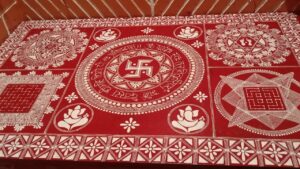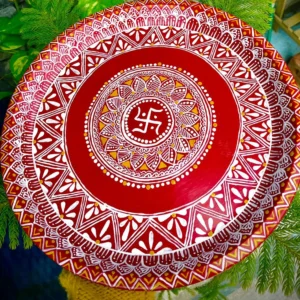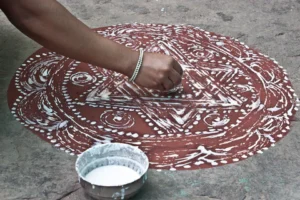The Aipan Painting of Uttarakhand from Kumaon region is home to the ancient ritualistic folk art known as Aipan, or Aipan art. It’s a type of Rangoli, where designs are painted on walls and floors in houses and temples to symbolize auspicious occasions, welcome, and good fortune. Aipan’s primary colors are red and white, though occasionally ochre or another hue might be seen as the base color. Typically, rice flour is used to make the white, and red ochre, or Geru, is a natural dye used to make the red.
Aipan art is known for its elaborate and symbolic designs that frequently include motifs like gods, goddesses, geometric patterns, flowers, and the swastika, a symbol of good luck.


Aipan is more than just a kind of art; it is a way of expressing culture and spirituality that is deeply ingrained in Kumaon local life Culture And Tradition. Traditionally, the women of the home handle it, particularly on festivals, marriages, and other significant occasions such as Makar Sankranti, Navratri, and Deepawali. Mothers educate their daughters the traditional designs and techniques of the art form, passing it down from generation to generation and protecting this priceless cultural legacy.
Paintings from the Aipan region require a synthesis of artistic talent, spiritual importance, and cultural tradition. The Kumaon region of Uttarakhand, India, has deep-rooted customs and ceremonies that incorporate these paintings, making them more than merely ornamental pieces. This is a simple tutorial on painting Aipans, which are known for their elaborate designs created from natural materials. Recall that Aipan art is mostly done on the walls and floors of houses and temples, particularly on auspicious days.
There are various procedures involved in developing Aipan Painting of Uttarakhand
1. Preparing the surface: The area designated for the creation of the Aipan is carefully cleaned.
2. Basis preparation: To establish a consistent basis, a paste consisting of rice flour is usually applied to the surface. In certain designs, a Geru background may be used initially.
3. Design drawing: The design is then carefully sketched by hand. The patterns can be made with a tiny stick or cotton fabric soaked in the rice solution.
4. Filling in: To create contrast and draw attention to the fine details, red ochre may be used to fill in the spaces between the patterns, depending on the design.

Cultural Importance
The Kumaon region places great cultural importance on Aipan. It is more than just a kind of art; it’s a way for individuals to communicate their devotion, aspirations, and prayers. During festivals, weddings, and other important occasions, the paintings are frequently seen. There are several designs that are connected to various holidays or customs. To bring the goddess Lakshmi into homes, for example, particular patterns are drawn during the Diwali celebration.
Types Of Aipan Painting in Uttarakhand
1. Lakshmi Pujan Aipan: Diwali and other festivals dedicated to the worship of Goddess Lakshmi. Design elements Footprints, which represent the advent of Goddess Lakshmi and denote wealth and prosperity, are frequently included.
2. Chowki Aipan: A number of religious rituals involving the placement of gods or other holy objects for devotion. Design features include circular patterns with a lotus in the middle, symbolizing the cosmos and the holy.
3. Diwali Aipan: Deepawali, other than Laxmi Pujan. Design elements are Rangoli-style patterns, intended to welcome guests and gods into the home during the festival, may incorporate diyas (lamps) and symbols of prosperity.
4. Janeyu Aipan:Upanayana (ceremony of the sacred thread). Design elements include themes that represent purity and spiritual enlightenment as well as symbols related to the ceremony, such as the sacred thread.
